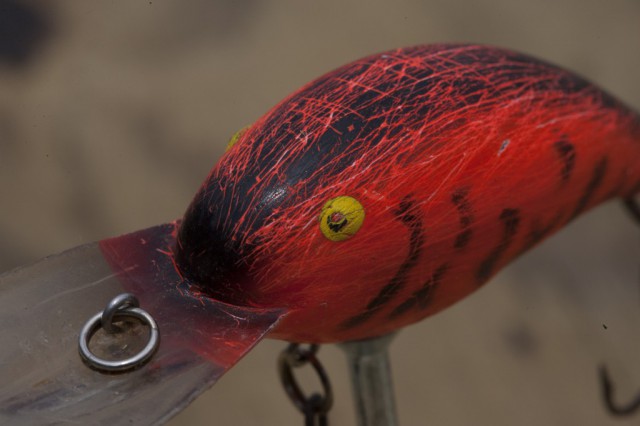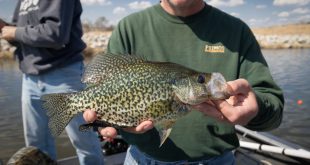If you are really trying to catch fish, it’s definitely going to happen. So don’t even worry about it. But what should you do once you are snagged?
Wait, let me back up. First, if you never want to get hung up, stay at the house. If you rarely want to get hung up, however, use only weedless lures. Scum frogs, grass mice, floating plastics, weedless jigs – all are good for throwing wherever and whenever you want. The next lure on the depth chart is definitely a spinnerbait. This lure is relatively weedless as well and can access most places. When thrown over a limb or other obstruction, slowly reeling it back over can usually keep this lure from snagging. For all other hangups, read on.
Emergent Hangups
Say you’re working a likely looking shoreline full of stumps and trees and your first cast of the day overshoots your target and gets hung up. Most people immediately give up after a cast like this and automatically head for the lure, disturbing fish they might have caught.
Sure, that’s an option, but it isn’t your only one and it shouldn’t be your first. If you make a bad cast over a limb near the water, lower the lure to the water and twitch it on the surface. If a fish hits, it’s going to absorb the lure’s hooks, which would otherwise snag the lure. Then you can pull your fish over the obstruction, assuming, of course, you’re using heavy line. If no fish strikes, make a judgment call. If it’s a huge tree trunk where the lure isn’t visible, you’ll have to pull the lure over the trunk. Raise your rod tip and experiment on how hard to jerk. Usually a simple twitch of the wrist is good enough to get it away from most obstructions. That also allows the lure to stay close to the stump once it’s back in the water. Getting untangled is not enough; turning a bad cast into a great cast is the most important part. If your lure is hung in a tree limb and it’s too high to entice a fish, get the lure swinging. Then while it’s swinging away from you, use a gentle twitch to flip the lure free from the branch. However, if you surmise that swinging the lure above that limb will entangle it in another limb, let out enough line so that the lure lowers to the point where you can retrieve it by hand.
Now, a worse-case scenario of events. You throw your lure and it gets entangled in a pine tree, a piece of netting, a rope, or a crack in a boat dock. This is simple. Give a slight tug on your lure. If it won’t come, go get it.
Submergent Hangups
When fishing with a crankbait or spinnerbait, watch your line. When the line stops as you continue to reel, the lure is about to go over an underwater limb. If fishing with a floating crankbait, stop reeling and allow the lure to float to the surface. If fishing with a sinking lure, such as a spinnerbait, raise your rod top and gently twitch the lure with your wrist above the obstruction. Then you can continue reeling. What if your line stops with a big fish? A possibility, yes, but 99 percent of the time the lure will make some sort of other movement such as a left or right swing when a fish takes it. Second, watch the emergent structure to guess where the submergent structure is. If fishing with a suspending or sinking lure, simply lifting the rod tip while reeling will allow the lure to move over most underwater structure.
If the lure is snagged beneath the water, you have multiple options. First, reel until the rod tip is touching the lure. Then push the rod tip away from you in the opposite direction that the lure was originally swimming. If fishing with a baitcaster, keep your thumb on the spool. If this doesn’t work or if your rod tip becomes entangled with your lure, you’ll then be able to release your spool to prevent your rod from breaking if the tip is bent too far in one direction. Second, move the boat to the opposite side of the snag and pull. This allows your lure to come out the same way it came in. This also works well if you can’t reach your lure with your rod tip. If fishing from the bank, change the angle. If you can’t get on the opposite side, move as far to the left or right as possible and pull. Third, there are several companies who make tools that connect to your line and slide down to free the lure from a snag. When fishing deepdiving crankbaits, this is sometimes the only way to untangle a lure without losing it.
Fourth, if fishing near riprap, use the bow technique: Tighten your line, then use your fingers and pluck at the line from the reel to the first eyelet as if you were playing a guitar. The momentum of the pluck may jar your lure loose beneath the water. This technique works best with monofilament line because of its ability to stretch. If none of these techniques work, position the boat on the opposite side, reel down as far as you can in the water with your thumb on the spool, and pull toward you. This will either break the limb, break the knot or straighten the hook. The problem with this technique is when fishing with braided lines that can exceed tests of over 100 pounds. You must also make sure that when pulling, you are pulling straight so the rod tip is not broken in the process. And with all of these techniques, protect yourself from flying lures – a three dollar fishing lure isn’t worth losing an eye over. The object when getting unhung is to get your lure out of trouble and put it in a fish’s mouth as quickly as possible. Learning these techniques will allow you to have the confidence to make casts in areas with better structure for fish. Don’t try to throw in the trees on purpose, but make sure you’re not pulling back on casts that might have otherwise landed right in a fish’s living room. When you start having more confidence making casts whenever and wherever you want to, you’ll see your fishing success increase dramatically.

 Nebraskaland Magazine
Nebraskaland Magazine



